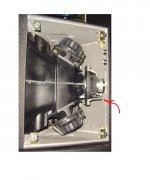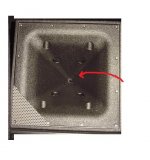The KEFs have been Klippel tested and the results are on DIYMA.
I found a review of the Q100 on zaphaudio and a review of the HTS3001SE from diyma member 'bikinpunk' here:
Kef’s HTS3001SE… I cracked the Egg! | Medley's Musings
But both of those drivers are larger and more expensive than the one I have. Also, the small cheap Kef driver, the one I bought, is quite a bit better suited to horn loading. This is because the cone on the cheap one is much much lighter, yielding a horn-friendly qts value.
A funny thing happened:
1) I noticed the Kefs image better than anything I've ever owned
2) I noticed the Kefs are really articulate, and work well in small spaces
Seriously, try the 3005SE's. (I know "bikini" Erin is selling the pair he tested...)
I have some of both the 1005.2's (I think that's the number) and the 3005SE's, as well as Q100's. Imaging is a step above, perhaps due to the proto-Tangerine phase plug on the tweeter. Not to mention the extra octave of extension. They're the best thing in that size class I've ever heard. The Q100's better them when playing loud, especially in the upper midrange (much stouter tweeter), but none of these little drivers are really designed for "loud."
But both of those drivers are larger and more expensive than the one I have. Also, the small cheap Kef driver, the one I bought, is quite a bit better suited to horn loading. This is because the cone on the cheap one is much much lighter, yielding a horn-friendly qts value.
The limiting factor there will be the tiny tweeter. Though the small tweeter is the limiting factor on the 3005, too.
The problem with Synergy horns in home type listening situations is that so few people have ever actually heard them that way. I have a long thread going on over at DIYsoundgroup about a DIY synergy horn design for home use - yet, I've still never heard an actual Synergy horn! I'm just going on what I got from following patent descriptions and webposts, no idea what similarities there may really be in sound between mine and real ones. There just don't seem to be many places to hear Synergies, other than maybe in stadiums. Is there any chance of a Synergy demo/audition at some upcoming audio show (east/central area please)? They currently seem to be mythic since people only hear about them, seldom actually get to hear them.
I had the same problem. The way that I found one was by re-constructing the old Lambda Acoustics website using The Wayback Machine, then emailing people that owned Unities.
(Patrick Bateman, Unity Horn Stalker!)
Found someone that lived 20 miles away that had a set and got a demo.
(Patrick Bateman, Unity Horn Stalker!)
Found someone that lived 20 miles away that had a set and got a demo.
Like in one of my posts above, I want to seal the rear of the 3FE20 just like Danley sealed the rear of the BMS 5CN140 used in the SM-60F. See that attached picture. I copied the section of interest and outlined the cutaway chamber in red. It looks like getting to around 600Hz with the 3FE20 will be possible.
well, yeah, ok, it is ...and its a BMS...I think they have a new one

but the 4 small holes around the tweeter hole means the DC must be 'decoupled' from the cone with a tube or something
I dont think a coax will be needed in a unity for home use

Attachments
In the DSL SM-60 pictured in posts 656 and 655 the side mounted drivers cover the low range (-10 at 52 Hz), the 5" co-ax cone covers mids, the co-ax compression driver covers the highs.
If really high SPL is not needed, a single co-ax can be used to drive a Synergy horn.
What is the "B&O filler-driver principle" ?
If really high SPL is not needed, a single co-ax can be used to drive a Synergy horn.
What is the "B&O filler-driver principle" ?
I've been messing with Unity horns for close to three years now, and I've managed to purchase a pile of midrange drivers that work on Unity horns. <snip>
My collection of drivers is getting a bit ridiculous, and I intend to move into a new house in the next few months. I have posted an eBay add for my set of Misco JC5RTF-Bs. I believe it violates forum rules to post the link, but anyone can find my add easily. (Hint : it's the only set of JC5RTF-Bs on eBay, in fact it's the only set of Misco woofers on eBay.)
The lead time to have these built is a bit lengthy, and I'd be willing to bet they cost more nowadays, due to the rise in neodymium.
Long story short: get 'em while you can!
If you seal the back off on these they should work for a Unity. But you can also do some interesting things with these in a back loaded horn.
What is the "B&O filler-driver principle" ?
it was a 2way using 3 drivers
an attempt to use a too big woofer in a 2way
the third 'filler driver' would be a smaller woofer or mid
in short, its a 2way where the 2 driver are croossed a bit too early, so to speak
and the third driver is just 'filling in', at lower SPL
but it can be used in other different ways
and since its often about a bit too big woofer, and a CD/tweeter crossed a bit too low...
and furthermore, we have these big physical sizes that never seem to match...
well, that would my reasoning for the unity horn
different than original, yes...but a home, or a small instrument rig is not for a big stadium either
and regarding the tweeter, yes I believe mr geddes is right when he says troath transistion smoothness is absolutely crutial to smooth sound
so, for nice hifi-ish sound I reckon the passband unity mids should not play too loud, and only have minimal influence on the sound
hence the idea about combining it with the filler-driver principle
and thinking back again, yes the coax might actually have been perfect and doing the filler duty, and no other drivers
only problem is, it may not have the needed smooth troath transistion
The new JBL M2 uses a unity-ish arrangement for frequency range of 800hz to 20khz. It appears that there are two ring radiators, operating face-to-face, and the output of the rings are horn loaded via a common channel.
Interesting stuff. This is the second time I've noticed JBL copping some Unity-type technology. (The first was the midranges in one of their array lines.)
I wonder how similar this JBL dual diaphragm ring radiator is to BMS's dual diaphragm ring radiator?
Some pics of the response, to give you an idea of it's performance.
An externally hosted image should be here but it was not working when we last tested it.
Also, for lulz, here's a pic of my first horn speakers, which I bought based on a positive review in Stereophile, back when I was an audio noob. Second pic are my Summas. Third pic is the JBL M2. I'm seeing a family resemblance here
Quite dissimilar, the BMS uses concentric annular diaphragms of different diameters covering different frequency ranges.
The JBL D2 (used in the M2 loudspeaker) doubles diaphragm area in a small diameter driver, a good feature when multiple drivers are used in a vertical arrangement (as in their small format line array speakers), or when a low crossover point with low distortion is required, as in the M2.
The BMS dual concentric could be thought of as "unity-ish", while the JBL D2 is just a far more elegant way of doing what was done with the old JBL 2329 "Y" throat adapter.
The JBL D2 (used in the M2 loudspeaker) doubles diaphragm area in a small diameter driver, a good feature when multiple drivers are used in a vertical arrangement (as in their small format line array speakers), or when a low crossover point with low distortion is required, as in the M2.
The BMS dual concentric could be thought of as "unity-ish", while the JBL D2 is just a far more elegant way of doing what was done with the old JBL 2329 "Y" throat adapter.
Last edited:
Woah, is that a pair of HLS 810? I found one at the swapmeet, and was mad when the couldn't find the other one. I wanted a pair, and they were CHEAP. I had purchased a pair at cost when I worked for a consumer retailer back in the day. Best sounding cheap speakers I have ever owned. I was leary at first as I didn't like low model Klipsch. But these were fun... (no bass, but I was ok with that at the time)
I am curious to see if anyone in america comes up with a synergy or unity build that uses decent drivers. I am still considering playing with unity (I will have a pair of CD's by end of summer to play with for econowaves, too)...
I am curious to see if anyone in america comes up with a synergy or unity build that uses decent drivers. I am still considering playing with unity (I will have a pair of CD's by end of summer to play with for econowaves, too)...
Yep, that's the one. Back in the 90s I was drinking the Stereophile kool-aid, and Corey Greenberg gave a positive mention to the JBLs. It seemed like the magazine would only recommend cheap speakers if they didn't have any bass, so the the HLS 810s were a welcome exception. To this day, they are the only speakers I've purchased twice. (Bought my first pair at Best Buy, sold them when I went DIY, then realized that my DIY design didn't sound any better. So I bought another set of the JBLs.)
- Home
- Loudspeakers
- Multi-Way
- Suitable midrange cone, for bandpass mid in Unity horn.


